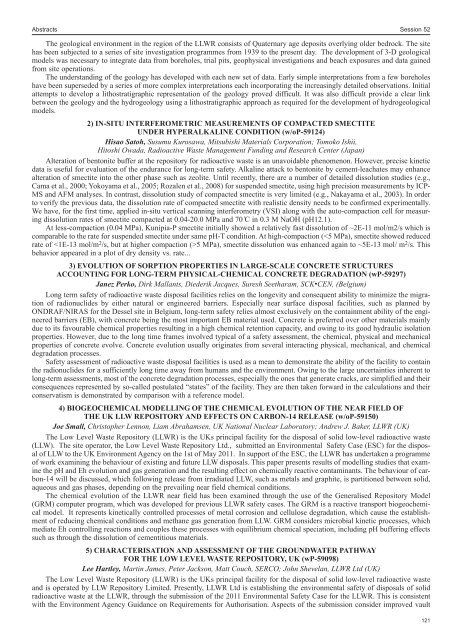ICEM11 Final Program 9.7.11pm_ICEM07 Final Program ... - Events
ICEM11 Final Program 9.7.11pm_ICEM07 Final Program ... - Events
ICEM11 Final Program 9.7.11pm_ICEM07 Final Program ... - Events
Create successful ePaper yourself
Turn your PDF publications into a flip-book with our unique Google optimized e-Paper software.
Abstracts Session 52<br />
The geological environment in the region of the LLWR consists of Quaternary age deposits overlying older bedrock. The site<br />
has been subjected to a series of site investigation programmes from 1939 to the present day. The development of 3-D geological<br />
models was necessary to integrate data from boreholes, trial pits, geophysical investigations and beach exposures and data gained<br />
from site operations.<br />
The understanding of the geology has developed with each new set of data. Early simple interpretations from a few boreholes<br />
have been superseded by a series of more complex interpretations each incorporating the increasingly detailed observations. Initial<br />
attempts to develop a lithostratigraphic representation of the geology proved difficult. It was also difficult provide a clear link<br />
between the geology and the hydrogeology using a lithostratigraphic approach as required for the development of hydrogeological<br />
models.<br />
2) IN-SITU INTERFEROMETRIC MEASUREMENTS OF COMPACTED SMECTITE<br />
UNDER HYPERALKALINE CONDITION (w/oP-59124)<br />
Hisao Satoh, Susumu Kurosawa, Mitsubishi Materials Corporation; Tomoko Ishii,<br />
Hitoshi Owada, Radioactive Waste Management Funding and Research Center (Japan)<br />
Alteration of bentonite buffer at the repository for radioactive waste is an unavoidable phenomenon. However, precise kinetic<br />
data is useful for evaluation of the endurance for long-term safety. Alkaline attack to bentonite by cement-leachates may enhance<br />
alteration of smectite into the other phase such as zeolite. Until recently, there are a number of detailed dissolution studies (e.g.,<br />
Cama et al., 2000; Yokoyama et al., 2005; Rozalen et al., 2008) for suspended smectite, using high precision measurements by ICP-<br />
MS and AFM analyses. In contrast, dissolution study of compacted smectite is very limited (e.g., Nakayama et al., 2003). In order<br />
to verify the previous data, the dissolution rate of compacted smectite with realistic density needs to be confirmed experimentally.<br />
We have, for the first time, applied in-situ vertical scanning interferometry (VSI) along with the auto-compaction cell for measuring<br />
dissolution rates of smectite compacted at 0.04-20.0 MPa and 70 ̊C in 0.3 M NaOH (pH12.1).<br />
At less-compaction (0.04 MPa), Kunipia-P smectite initially showed a relatively fast dissolution of ~2E-11 mol/m2/s which is<br />
comparable to the rate for suspended smectite under same pH-T condition. At high-compaction (
















